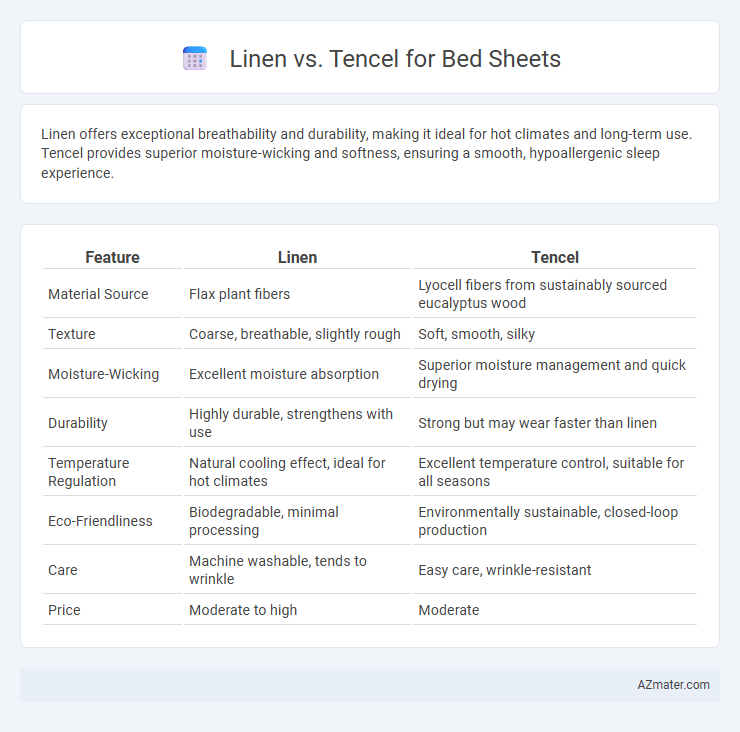Linen offers exceptional breathability and durability, making it ideal for hot climates and long-term use. Tencel provides superior moisture-wicking and softness, ensuring a smooth, hypoallergenic sleep experience.
Table of Comparison
| Feature | Linen | Tencel |
|---|---|---|
| Material Source | Flax plant fibers | Lyocell fibers from sustainably sourced eucalyptus wood |
| Texture | Coarse, breathable, slightly rough | Soft, smooth, silky |
| Moisture-Wicking | Excellent moisture absorption | Superior moisture management and quick drying |
| Durability | Highly durable, strengthens with use | Strong but may wear faster than linen |
| Temperature Regulation | Natural cooling effect, ideal for hot climates | Excellent temperature control, suitable for all seasons |
| Eco-Friendliness | Biodegradable, minimal processing | Environmentally sustainable, closed-loop production |
| Care | Machine washable, tends to wrinkle | Easy care, wrinkle-resistant |
| Price | Moderate to high | Moderate |
Introduction to Linen and Tencel Bed Sheets
Linen bed sheets, made from natural flax fibers, offer exceptional breathability, durability, and moisture-wicking properties, making them ideal for hot sleepers and those seeking eco-friendly bedding. Tencel bed sheets, derived from sustainably sourced eucalyptus wood pulp through an environmentally responsible process, provide a smooth, silky texture combined with excellent moisture management and hypoallergenic qualities. Both linen and Tencel sheets lead the market in sustainable bedding, with Linen excelling in texture and longevity while Tencel shines in softness and skin sensitivity.
What is Linen? Key Features and Benefits
Linen is a natural fiber derived from the flax plant, known for its exceptional breathability and moisture-wicking properties, making it ideal for bed sheets in warm climates. Its durability and strength surpass many fabrics, offering long-lasting softness that improves with each wash. Linen's naturally hypoallergenic and antimicrobial qualities promote a healthy sleep environment, reducing allergens and irritants.
What is Tencel? Key Features and Benefits
Tencel is a sustainable fabric made from wood pulp, primarily eucalyptus trees, known for its eco-friendly production process that uses less water and energy. It offers key features such as exceptional softness, breathability, moisture-wicking properties, and natural hypoallergenic benefits ideal for sensitive skin. Compared to linen, Tencel sheets provide a smooth, silky texture with enhanced durability and resistance to wrinkles, making them a popular choice for comfortable, luxurious bedding.
Comparing Comfort: Linen vs Tencel
Linen offers exceptional breathability and moisture-wicking properties, making it ideal for hot sleepers who value a cool, crisp feel. Tencel provides a smooth, silky texture with excellent moisture absorption and hypoallergenic qualities, catering to those seeking softness and skin sensitivity relief. Both materials enhance sleep comfort but cater to different preferences: linen for durability and airflow, Tencel for softness and gentle touch.
Breathability and Temperature Regulation
Linen bed sheets excel in breathability due to their natural flax fibers, allowing air to flow freely and wick away moisture, which keeps sleepers cool in warm climates. Tencel sheets, made from eucalyptus cellulose, offer superior moisture-wicking and temperature regulation, adapting to body heat to provide a consistently comfortable sleep environment. Both materials outperform cotton in managing temperature, but linen is ideal for hot, dry conditions, while Tencel suits those needing moisture control and softness in humid environments.
Durability and Longevity
Linen bed sheets are known for their exceptional durability, becoming softer and stronger with each wash, often lasting for decades with proper care. Tencel sheets offer impressive longevity due to their moisture-wicking properties and resistance to wear, but typically have a slightly shorter lifespan compared to traditional linen. Both fabrics provide long-term value, with linen excelling in resilience and Tencel in maintaining smoothness over time.
Sustainability and Eco-Friendliness
Linen bed sheets, made from flax fibers, are highly sustainable due to their low water and pesticide requirements, biodegradable nature, and long lifespan, making them an eco-friendly choice. Tencel sheets, derived from sustainably sourced eucalyptus wood pulp via a closed-loop production process, offer excellent biodegradability and minimal environmental impact while using less land and water compared to conventional fabrics. Both options provide durable, breathable bedding with strong sustainability credentials, but Tencel's innovative manufacturing and renewable sourcing often result in a lower overall carbon footprint.
Care and Maintenance Requirements
Linen bed sheets require gentle washing in cold water and should be air-dried to maintain their natural fibers and prevent shrinkage, while Tencel sheets are machine washable at moderate temperatures and dry quickly without losing softness. Linen may become softer and more breathable over time but demands occasional ironing to reduce wrinkles, whereas Tencel resists wrinkles and retains its silky texture with minimal care. Both materials benefit from avoiding bleach and fabric softeners to preserve fabric integrity and extend the lifespan of the bedding.
Cost Comparison and Value for Money
Linen bed sheets typically cost more upfront than Tencel, with prices averaging between $100 to $250 for a queen set, reflecting their durability and natural breathability. Tencel sheets usually range from $80 to $150, offering a softer texture and moisture-wicking properties at a lower price point. When evaluating value for money, linen's long-lasting strength and improved softness over time justify its higher cost, while Tencel provides excellent comfort and eco-friendly benefits at a more affordable price.
Which is Better: Linen or Tencel for Bed Sheets?
Linen bed sheets, made from flax fibers, offer exceptional breathability and durability, making them ideal for warm climates and long-term use. Tencel sheets, derived from sustainably sourced eucalyptus wood pulp, provide a silky smooth texture, superior moisture-wicking, and hypoallergenic properties, enhancing comfort and skin health. Choosing between linen and Tencel depends on preference for natural breathability and rustic texture versus a softer, eco-friendly fabric with advanced moisture management.

Infographic: Linen vs Tencel for Bed Sheet
 azmater.com
azmater.com